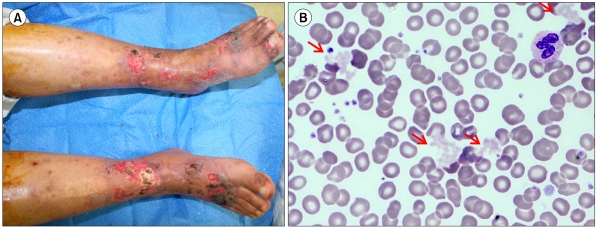
A 75-year-old man with a 2-year history of end-stage renal disease had skin lesions on both feet (A) for 2 weeks. The cause of end-stage renal disease remained to be clarified. Initial laboratory tests showed the following values: Hb level, 4.6 g/dL; leukocyte count, 4.6×109/L; and platelet count, 483×109/L. Peripheral blood (PB) smear showed extracellular aggregates of pink-tan acellular material (B). We suspected cryoglobulinemia and performed the cryoglobulin test. The sampling was performed using a warmed syringe and a test tube. The patient was positive with a very high cryocrit level (37.02%). Immunofixation showed a monoclonal IgG kappa band in the gamma region. The patient was negative for hepatitis and HIV. Biopsy of the skin lesion showed leukocytoclastic vasculitis with subcorneal bulla. A subsequent bone marrow (BM) examination showed no evidence of clonal plasma cells (<2%). Flow cytometric analyses showed increased proportion of B cells (PB, 24.4&; BM aspirates, 25.5%) with no clonality. Cytogenetic study revealed normal karyotype of 46,XY. The patient was diagnosed with type I cryoglobulinemia with cryoglobulinemic vasculitis and monoclonal gammopathy. Treatment with methyl prednisolone improved his clinical response. Our data indicate that cryoglobulin could be easily detected by PB smear.




 PDF
PDF ePub
ePub Citation
Citation Print
Print


 XML Download
XML Download